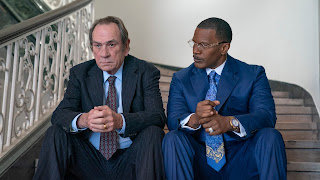Faith in Film, Week 8
For our second week of The Stand, we're looking at The Last Word on Evil. And when you're looking at evil in The Stand, that naturally means looking at Randall Flagg. Last week we focused more on Mother Abigail, and her role in the dreams. This week, we'll look at her opposite number, and how it meshes with what we see in Revelation 6-7.
But it's also a time to consider the novel upon which this story is based. Stephen King originally published The Stand in 1978. In that original version, all the action took place during the summer of 1980. So it was a bit of a future looking piece. It expands upon the scenario of his earlier short story Night Surf, and presents a detailed vision of the total breakdown of society after the accidental release of a strain of influenza that had been modified for biological warfare causes an apocalyptic pandemic, killing off over 99% of the world's population. Published in 1978, The Stand is the fourth and longest novel King published.
If you purchased the book more recently and have read it in preparation for this discussion, you’re probably thinking there are references in there that couldn’t have happened in that time frame. And that’s because The Stand is a book that has a varied history and, in fact, you could be reading a story set in an entirely different time frame depending on the version of the story that you picked up. The novel was originally published in 1978 in hardcover, with a setting date of 1980, in abridged form. The first paperback release in 1980 changed the setting date to 1985. The novel marks the first appearance of Randall Flagg, King's recurring antagonist, whom King would bring back many times in his later writings.
In 1990, an unabridged edition of The Stand was published, billed as "The Complete and Uncut Edition." Published in hardcover by Doubleday in May 1990, this became the longest book published by King at 1152 pages. When the novel was originally published in 1978, Doubleday warned King that the book's size would make it too expensive for the market to bear. As a result, he cut about 400 pages (around 150,000 words) from the original manuscript. This edition reinstates most of the deleted pages (as selected by King), as well as updates the setting from the 1980s to the 1990s. This new edition features a new preface by King, and illustrations by Bernie Wrightson. Additionally, Doubleday published a deluxe edition of The Stand: The Complete & Uncut Edition, limited to 1,250 numbered copies and 52 lettered copies. This edition, known as the "Coffin Box" edition due to the book being housed in a wooden case, was signed by King and Wrightson.
This is a novel that’s been extremely popular since it was released, earning rave reviews and awards when it was first offered to the public in 1978. And it’s continued to be one of his most popular ever since. There have been many attempts to adapt it to the screen, including a number of failed movie adaptations both before and after the 1994 mini-series. And as I mentioned it’s currently being adapted as a limited series for CBS All Access that will debut in 2020, so it’s a story that continues to appeal to people.
For King, the inspiration from this story came from wanting to do his own epic. And a part of that inspiration came from a place that will be familiar to believers. On his official site, this is what King says of his inspiration for The Stand: “For a long time--ten years, at least--I had wanted to write a fantasy epic like The Lord of the Rings, only with an American setting. I just couldn't figure out how to do it. Then, slowly after my wife and kids and I moved to Boulder, Colorado, I saw a 60 Minutes segment on CBW (chemical-biological warfare). I never forgot the gruesome footage of the test mice shuddering, convulsing, and dying, all in twenty seconds or less. That got me remembering a chemical spill in Utah that killed a bunch of sheep (these were canisters on their way to some burial ground; they fell off the truck and ruptured). I remembered a news reporter saying, "If the winds had been blowing the other way, there was Salt Lake City." This incident later served as the basis of a movie called Rage, starring George C. Scott, but before it was released, I was deep into The Stand, finally writing my American fantasy epic, set in a plague-decimated USA. Only instead of a hobbit, my hero was a Texan named Stu Redman, and instead of a Dark Lord, my villain was a ruthless drifter and supernatural madman named Randall Flagg. The land of Mordor ("where the shadows lie, according to Tolkien) was played by Las Vegas.”
We'll look at that and more as we consider The Stand and its take on Evil Wednesday night.
Discussion Questions:
1. The Stand was first released in 1978, and has been updated a few times since, always adjusting the time period. Why is a story like this timeless?
2. In the mini-series, as discussed last week, the survivors are called to Mother Abigail or Randall Flagg. What does Flagg offer that appeals to those who follow him?
3. In the depiction offered in Revelation 7, who is fit to stand against evil at the end?




Comments
Post a Comment